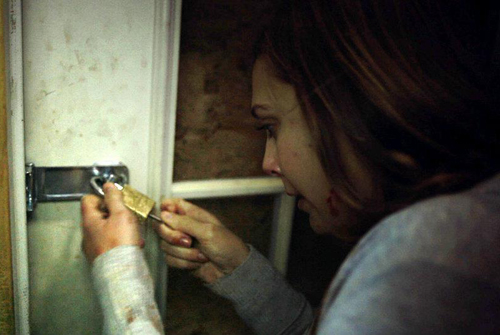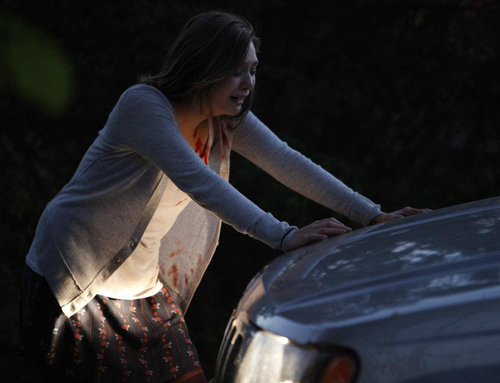Silent House | reviews, news & interviews
Silent House
Silent House
Low-budget spookathon chills the spine but then drops the ball

Considerable quantities of bile have been hosed over Silent House by American critics, who have found its premise flimsy and its execution dismally predictable. It was made by Chris Kentis and Laura Lau, who were also responsible for 2003's low-budget hit Open Water. That was the one where a couple of objectionable yuppies were left behind by their dive-boat and we bobbed about in the ocean with them as they succumbed to terror, hypothermia and hungry sharks.
Similar criticism could be levelled at Silent House, in which Kentis and Lau have likewise built a horror movie (based on a Uruguayan original) by drawing up a set of technical restrictions and then showing how ingeniously they can overcome them. The budget is low, to start with. It was just enough to cover a handful of actors and a single set, to wit: one house (though it isn't all that silent, being beset with all manner of thumps, moans, groans and creaks). It's a decrepit lakeside holiday home, which is being cleared out in preparation for sale by Sarah (Elizabeth Olsen), her father John (Adam Trese) and her uncle Peter (Eric Sheffer Stevens).
 With all the windows boarded up, the doors padlocked to keep out squatters and the electricity turned off, the house is dark and prison-like even in daytime, and becomes a suffocating black hole in which Sarah is forced to confront dimly-seen adversaries amid steadily mounting hysteria. The film-makers would like to persuade us that the piece was shot in real time in a single 88-minute take, with the camera sticking at Sarah's side as she tries to make sense of her predicament, but the illusion doesn't work since much craft has demonstrably been applied to the editing (Olsen in peril, pictured above and below).
With all the windows boarded up, the doors padlocked to keep out squatters and the electricity turned off, the house is dark and prison-like even in daytime, and becomes a suffocating black hole in which Sarah is forced to confront dimly-seen adversaries amid steadily mounting hysteria. The film-makers would like to persuade us that the piece was shot in real time in a single 88-minute take, with the camera sticking at Sarah's side as she tries to make sense of her predicament, but the illusion doesn't work since much craft has demonstrably been applied to the editing (Olsen in peril, pictured above and below).
Nonetheless, for two-thirds of its length the film successfully ratchets up the chills, even if the girl-trapped-in-spooky-old-house motif is about as original as daytime repeats of Murder, She Wrote. Shooting with brutally shortened depth of field has effectively intensified the sense of claustrophobia, with backgrounds reduced to a blur and characters' faces moving in and out of focus as they make the smallest of movements.
The smartest choice Kentis and Lau made was to cast Olsen in the lead - not that she has much competition, since Trese and Stevens could have been replaced by a couple of deckchairs and not a lot would have been lost - since she imbues Sarah with a haunting sense of bemusement and uncertainty, as if she were a sleepwalker finding herself in a familiar place which she suddenly can't understand any more. This is underscored early in the piece by the appearance at the front door of Sophia (Julia Taylor Ross), apparently a girl who lives nearby and who used to play with Sarah when they were children. Sarah tries to convince herself that she remembers Sophia, but her unease is palpable.
 Other clues have been laid whose significance only solidifies in hindsight, such as uncle Peter's ever-so-slightly inappropriate comment that he can't believe how grown up Sarah has become (does he mean her exaggerated cleavage?), or the old photographs left lying around the house, or Sarah's glimpse of a mysterious young girl in the garden. Tension is also maintained by deliberate misdirection, so we're left puzzling over whether the mysterious thumps and footsteps in the empty house are supernatural, extra-terrestrial or psychological. Are we catching echoes of The Others, or being teased by Shyamalan's Signs?
Other clues have been laid whose significance only solidifies in hindsight, such as uncle Peter's ever-so-slightly inappropriate comment that he can't believe how grown up Sarah has become (does he mean her exaggerated cleavage?), or the old photographs left lying around the house, or Sarah's glimpse of a mysterious young girl in the garden. Tension is also maintained by deliberate misdirection, so we're left puzzling over whether the mysterious thumps and footsteps in the empty house are supernatural, extra-terrestrial or psychological. Are we catching echoes of The Others, or being teased by Shyamalan's Signs?
There are several arrestingly knuckle-gnawing moments, especially the panicky sequence where Sarah is trapped in a pitch-black room and can only see in the intermittent flashes from a Polaroid camera, one of which illuminates something ghastly hurtling towards her. Sounds of a bottle rolling across the floorboards or billiard balls clacking together become harbingers of unknown terrors.
A shame, then, that having built up a hair-raising head of steam, Kentis and Lau wasted it by glueing a dogmatic lump of exposition on the end which explains everything in pedantic detail. This is doubly crass, since it's jarringly at odds with the previous ambiguity and disorientation, while also leaving you picking over the plot-holes where the preceding action doesn't accord with the supplied solution. But for Elizabeth Olsen at least, the only way is up.
Watch the trailer to Silent House
rating
Share this article
The future of Arts Journalism
You can stop theartsdesk.com closing!
We urgently need financing to survive. Our fundraising drive has thus far raised £49,000 but we need to reach £100,000 or we will be forced to close. Please contribute here: https://gofund.me/c3f6033d
And if you can forward this information to anyone who might assist, we’d be grateful.

Subscribe to theartsdesk.com
Thank you for continuing to read our work on theartsdesk.com. For unlimited access to every article in its entirety, including our archive of more than 15,000 pieces, we're asking for £5 per month or £40 per year. We feel it's a very good deal, and hope you do too.
To take a subscription now simply click here.
And if you're looking for that extra gift for a friend or family member, why not treat them to a theartsdesk.com gift subscription?
more Film
 theartsdesk Q&A: filmmaker Dag Johan Haugerud on sex, love, and confusion in the modern world
The writer-director discusses first-love agony and ecstasy in 'Dreams', the opening UK installment of his 'Oslo Stories' trilogy
theartsdesk Q&A: filmmaker Dag Johan Haugerud on sex, love, and confusion in the modern world
The writer-director discusses first-love agony and ecstasy in 'Dreams', the opening UK installment of his 'Oslo Stories' trilogy
 Oslo Stories Trilogy: Dreams review - love lessons
First love's bliss begins a utopian city symphony
Oslo Stories Trilogy: Dreams review - love lessons
First love's bliss begins a utopian city symphony
 Blu-ray: Two Way Stretch / Heavens Above!
'Peak Sellers': two gems from a great comic actor in his prime
Blu-ray: Two Way Stretch / Heavens Above!
'Peak Sellers': two gems from a great comic actor in his prime
 Late Shift review - life and death in an understaffed Swiss hospital
Petra Volpe directs Leonie Benesch in a compelling medical drama
Late Shift review - life and death in an understaffed Swiss hospital
Petra Volpe directs Leonie Benesch in a compelling medical drama
 The Naked Gun review - farce, slapstick and crass stupidity
Pamela Anderson and Liam Neeson put a retro spin on the Police Squad files
The Naked Gun review - farce, slapstick and crass stupidity
Pamela Anderson and Liam Neeson put a retro spin on the Police Squad files
 theartsdesk Q&A: actor Lars Eidinger on 'Dying' and loving the second half of life
The German star talks about playing the director's alter ego in a tormented family drama
theartsdesk Q&A: actor Lars Eidinger on 'Dying' and loving the second half of life
The German star talks about playing the director's alter ego in a tormented family drama
 The Fantastic Four: First Steps review - innocence regained
Marvel's original super-group return to fun, idealistic first principles
The Fantastic Four: First Steps review - innocence regained
Marvel's original super-group return to fun, idealistic first principles
 Dying review - they fuck you up, your mum and dad
Family dysfunction is at the heart of a quietly mesmerising German drama
Dying review - they fuck you up, your mum and dad
Family dysfunction is at the heart of a quietly mesmerising German drama
 theartsdesk Q&A: director Athina Rachel Tsangari on her brooding new film 'Harvest'
The Greek filmmaker talks about adapting Jim Crace's novel and putting the mercurial Caleb Landry Jones centre stage
theartsdesk Q&A: director Athina Rachel Tsangari on her brooding new film 'Harvest'
The Greek filmmaker talks about adapting Jim Crace's novel and putting the mercurial Caleb Landry Jones centre stage
 Blu-ray: The Rebel / The Punch and Judy Man
Tony Hancock's two film outings, newly remastered
Blu-ray: The Rebel / The Punch and Judy Man
Tony Hancock's two film outings, newly remastered
 The Ballad of Suzanne Césaire review - a mysterious silence
A black Caribbean Surrealist rebel obliquely remembered
The Ballad of Suzanne Césaire review - a mysterious silence
A black Caribbean Surrealist rebel obliquely remembered
 Harvest review - blood, barley and adaptation
An incandescent novel struggles to light up the screen
Harvest review - blood, barley and adaptation
An incandescent novel struggles to light up the screen

Add comment